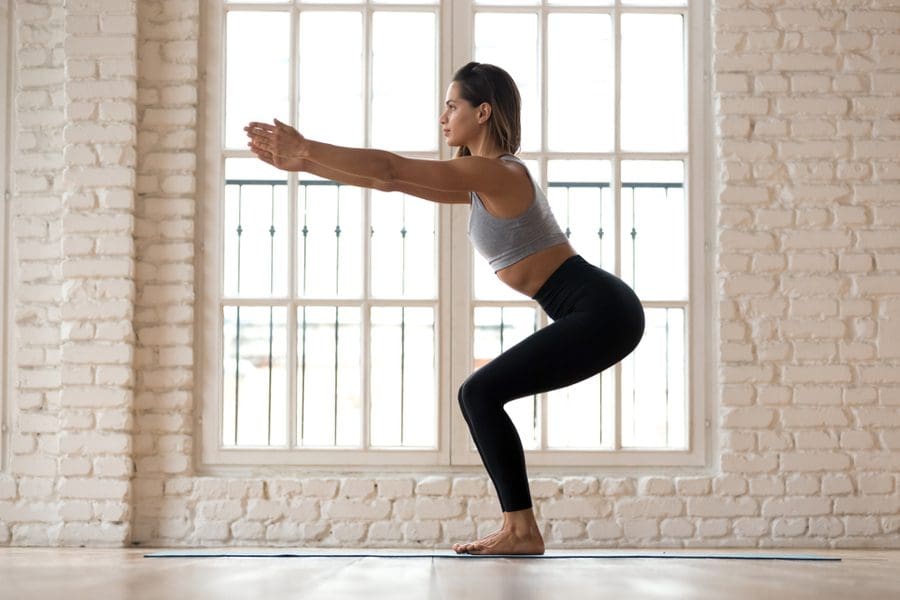Fitness can be a challenge when the gym is closed and you’re staying inside to stop the spread of coronavirus. Getting in shape is especially difficult for beginners who want to launch a workout routine without even a dumbbell lying around the house. One effective way you can build strength is using bodyweight exercises. These are simple moves that improve balance and flexibility without gym machines or equipment. Here are six beginner bodyweight exercises that will make those extra hours at home go by faster.
If you can, do each of these six in succession without a break for one circuit. Once you’ve finished one circuit, repeat for a second and then, if you can, go for a third. You’ll be tired and you may have to work up to three circuits, but that’s okay.
Trainers recommend putting workouts on your calendar just as if you were scheduling a visit to the gym. Set a time and plan a workout routine that you can stick to.
20 Bodyweight Squats
Stand with your feet at a comfortable width apart—either hip distance or slightly wider—and toes pointed forward in the same direction to create a solid base. Keep your eyes forward, chest up and heels planted. Push your hips back to lower into a squat. Think about pushing your knees out slightly to make sure your knees track over your ankles and don’t cave inward. Balance by reaching your arms straight out from your shoulders. Once you squat, push through your heels to return to standing.
If a bodyweight squat is too challenging because of strength, pain or mobility issues, make it easier by starting your squat from a seat. Or you can use a stable object such as a door frame, railing or bench to hold onto. Use the support to make sure you hold proper posture throughout the entire movement.
10 Push-Ups
The easiest are wall push-ups. After you’re comfortable with those, you can move on to elevated push-ups and then to knee push-ups before graduating to regular push-ups.
For a wall push-up, stand in front of a wall. Place your hands on the wall at slightly wider than shoulder-width apart.
Walk your feet backwards until your arms are fully extended and supporting your weight. One step back with both feet is usually enough. Keep your body in a straight line and lower yourself until your nose almost touches the wall, and then return to the starting position.
10 Lunges Each Leg
Start with forward lunges and, once you’re proficient, you may want to work up to walking lunges, which are more difficult.
For a forward lunge, stand with your feet hip-width apart. Place your hands on your hips or overhead or grab some water bottles for weights. Take a slow, controlled step forward with your right leg. Keeping your spine tall and the weight in your heels, lower your body until both your front and back legs form 90-degree angles with your knees directly over your ankles. Pause before bringing your right leg backward to return to starting position. Step forward with your left leg and repeat.
10 One-Arm Dumbbell Rows
Be especially careful if you have lower-back problems.
Stand to the right of a bench holding a something weighted in your right hand. Place your left knee and your left hand on the bench for support. With your right arm hanging down, bend forward from the hips so that your back is roughly parallel to the floor and your right knee is slightly bent.
Tilt your chin toward your chest to bring your neck in line with the rest of your spine. Pull your right arm up until your elbow is pointing to the ceiling and your upper arm is parallel to the floor. Lower the weight slowly back down.
15 Forearm Planks
Most people consider forearm planks the standard plank. Lie face down with legs extended. Elbows should be bent and directly under the shoulders. Palms should be flat on the floor. Place feet hip-width apart and elbows shoulder-width apart.
Engage your abs and tuck your toes to lift your body. Your forearms remain on the ground. Press away from the floor with forearms. Your body should form a straight line from shoulders to heels. Hold for 30 to 60 seconds.
30 Jumping or Walking Jacks
A walking jack is a low-impact modification that’s much easier on your knees. Stand tall. Step out wide to the side with your right foot and swing both arms out and extend straight up overhead, just as you would do in a jumping jack. Once the right lead foot is on the ground, step the left leg in close. At the same time, swing your arms back down to your starting position. After one side step, repeat the movement going the opposite direction.






